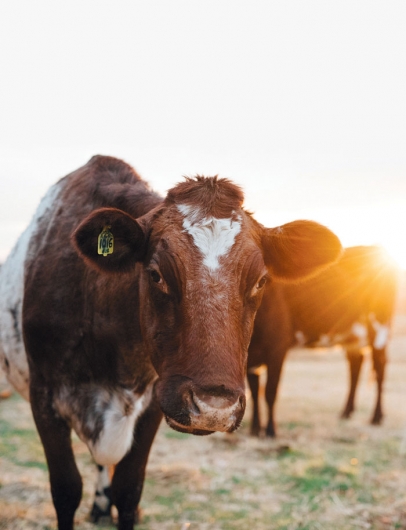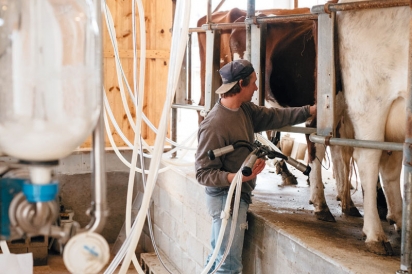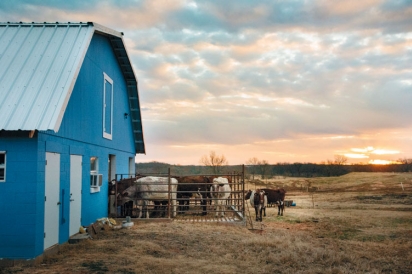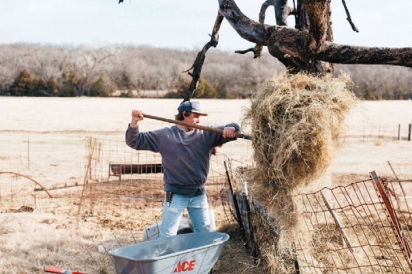Sweet Bovine Nectar
Marak’s Milk
115 years have passed since the Marak family laid down roots in Meeker, Oklahoma. But what once felt destined to continue, generation after generation, just came perilously close to dissolution.
Steve Marak laughs as he recounts the recent return of his son and fourth generation dairy farmer, Travis. Travis showed up to move back into the home his great-grandfather built right as Steve had begun the process of loading his beloved Shorthorns on a trailer to be sold. Despite initial reluctance to take over the farm, Travis had changed his mind.
Travis’ first taste of international travel was as a child alongside his father. The Marak mission to perfect and propagate the Milking Shorthorn Breed can be seen throughout the world as Shorthorns from other continents can be traced to the Marak’s herd in Meeker. As a young adult fresh out of college, Travis spent time on farms in New Zealand and Australia, and then he backpacked across Southeast Asia, China, Mongolia, Russia, Eastern Europe, Germany, Austria, and Belgium. Travis didn’t expect to feel the pull towards home, but while on his journey, he decided to head back to Meeker. Without him, the farm would cease to exist. With him, the legacy could continue.
Milking Shorthorns are scientifically described as docile bovines capable of producing large quantities of nutritious milk. I’d describe them as adorable and extraordinarily friendly. The Marak’s herd begins the day before dawn. The heifers make their way in from pasture, ready to be milked. The older ones bully their way to the front of the line, and then they clomp into the barn in a surprisingly orderly fashion. In fours, they line up for breakfast—heads in feeders, their udders in place. Travis carefully sanitizes the udders and preps for milking. A hum of machinery gives rhythm to the process. Above the hum, we hear Travis’ morning greetings to the ladies, accompanied by a “moo” here and there. When the first four are finished, Travis gives them a pat and sends them on their way. The next four move into position. The process is clean and meticulous. The barn, built by Travis and a neighbor, is perfectly suited for its purpose. Milk is pumped up a pipe, down into a syphon, and over into the next room where a large vat brings the milk to temperature. Raw in form, it is pure white and sweet smelling. Next, it will be pasteurized, then bottled. Milking takes place twice daily. The heifers are allowed to pasture and graze for the remaining twenty-three hours of the day.
With the sun rising higher, my photographer, Josh, and I are given a tour of the farm. Travis shrugs and calls it “not much to look at it.” We beg to differ. Josh continues to snap photos of our serene surroundings while we stop to watch calves being bottle fed. Pup, the farm dog, vies for my attention and whines for another belly rub.
Later in the pasture, we meet the heifers again. Among the ladies is a bull: he’s huge with a gold ring adorning his nose. I recognize the heifers from earlier as they encircle us. Their markings are memorable, but their temperaments are what distinguish them as individuals. I ask Travis to show me his favorite. Without hesitation, he said, “She’s a little ornery and reluctant at times to come in, but eventually comes around.” I laugh at his response, which sounds so familiar to how he described himself as a formerly reluctant dairy farmer. The two are kindred spirits.
Dairy farming is not a hobby or a side hustle; it is a lifestyle. The milk never stops. Travis spends his mornings and evenings in the barn. He spends two days a week doing deliveries. His bottling crew works earnestly, and he deeply appreciates their lifetime of experience. His dad serves as a guide; he’s tried it all and knows what works. Travis is thankful to be surrounded by experts, but can’t help feeling concern for the future. Farms are dwindling as the next generation sets out for lives and careers elsewhere. Travis now wants to prove that farming is a viable business option for young people. He’s certainly made a believer out of me.
Travis proudly describes the family farm as the little farm that could. “Our milk is from a herd of cows who are allowed to do cow things. It’s non-homogenized which helps preserve that super fresh bovine nectar flavor.” Travis likes to think he coined the term “bovine nectar.” I won’t argue with him.
Marak’s Milk, frequently found for sale on the same day it is produced and bottled, can be purchased at the Edmond Farmer’s Market (in season), The Meat House in Edmond, Okay Yeah Co. in OKC, 116 Market in Luther, Anthony’s Foods in Meeker, and in the kitchens of En Croûte as well as Cuppies and Joe. I ask him how others can help sustain his farm. Of course, he wants us to frequent the places that sell his milk, but more importantly he says, “Support not only our milk but other foods produced by farms like ours. Ask for local options at restaurants and stores. This will not only help me; it will ultimately make our food supply more sustainable.”











